Insect & Disease Conditions Update
Forest & Shade Tree - Insect & Disease Conditions for Maine
April 19, 2019
This is the first Conditions Report bulletin of 2019. This report contains significant news about emerald ash borer, gypsy moth and browntail moth and is worth reading if forests with ash and oak are part of your work or life portfolio.
A printer-friendly version of this report is available on-line from the Conditions Report Index.
In this Issue:
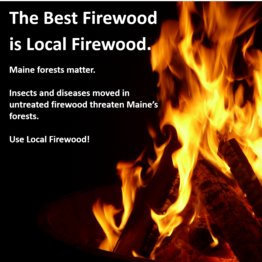
The beginning of a new season of outdoor recreation brings new focus to the dangers posed to our forests by invasive forest pests, often spread by infested firewood. Recreationists and camp owners need to be aware of the threats invasive forest pests pose to Maine’s natural resources. Of course, the discovery last year of emerald ash borer (EAB) in two areas within Maine adds even more urgency to this message.
It is still illegal to bring untreated firewood from out-of-state across Maine’s borders, even into areas that are quarantined for EAB. But with EAB located in the state, movement of firewood within the state becomes affected. It is now illegal to move untreated firewood from inside the EAB quarantined areas to areas outside the quarantines.
Even within the quarantined area, we ask people to consider how their actions can impact the movement of EAB and other forest threats. If you live in an area which is still free of EAB and have ash firewood from near an infested area, please try to burn it before May 1 when the risk of EAB adults emerging and flying starts to rise. And as always, we recommend burning firewood within 50 miles of where it was harvested. This reduces the chance of moving a yet-undiscovered pest long distances.
|

Browntail Moth (Euproctis chrysorrhoea) – It has been a busy browntail moth season for the Maine Forest Service already, with 17 browntail moth informational sessions since January. In collaboration with Dr. Ellie Groden and Karla Boyd at the University of Maine, a browntail winter web experiment, in which moth webs were subjected to various treatments, has shown some promising results.
Our winter web survey has wrapped up which included flights in a helicopter and fixed wing aircraft to determine the feasibility of spotting webs from the air/ surveying islands off the coast of Maine, respectively. Based on the winter web survey, we are bracing for another year of high browntail moth populations. There have been a few web clipping events this past winter, including one on Deer Isle that the Maine Forest Service took part in (See photo below). If you do find webs within reach, there is a brief time left in which populations can be reduced by removing and destroying the webs (soak in soapy water or burn, see the video resource on our website). Be aware that remnants of cocoons and cast skins of caterpillars can be present in the trees; this work is best done with covered skin and not by sensitive individuals.
We are working with the CDC to develop a list of frequently asked questions to better serve the public.
|
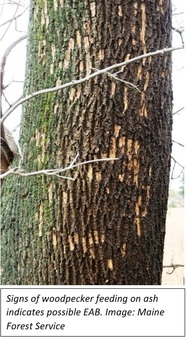
Emerald Ash Borer (Agrilus planipennis) – Following the detection of emerald ash borer (EAB) in Aroostook County and York County, delimiting surveys and a public rule-making process, a formal quarantine on EAB was announced this week. It includes all of York County and eighteen towns in the northeastern corner of Aroostook County (detailed maps available at www.maine.gov/eab).
In most of Maine, it is still too early to be treating specimen ash with pesticides to protect them. Experts recommend holding off treatment until the nearest known detection of EAB is within 10–15 miles of the trees in question. In the meantime, resources are better spent on inventorying ash, monitoring for the pest, and preparing for its arrival. If you are within 10 miles of a known EAB infestation and wish to treat your trees, information about protecting high-value ash trees can be found at www.maine.gov/eab.
Girdled trap trees last year in northern Aroostook County provided valuable information about the location, density, and age of EAB infestations. These surveys laid the groundwork for release of biological control agents in that area this summer. Unfortunately, we have less information about EAB in York County. We hope to establish a network of girdled trap trees in southern York County this spring to provide the information needed for release of biocontrol agents in this area.
If you are a Maine landowner and have ash trees on your land, consider creating a girdled trap tree to monitor for EAB. We are looking for trees in the Grand Isle area in northern Maine, and in southern York County near the New Hampshire border; however additional monitoring will be of help anywhere in Maine. If you have an ash tree of any species (not mountain ash) over four inches in diameter that you would be willing to girdle as a trap tree, please email Colleen Teerling (colleen.teerling@maine.gov) with the subject line “Trap Tree” and we will help you create a trap tree this spring. More information can be found at: http://www.maine.gov/dacf/mfs/forest_health/invasive_threats/eab_trap_trees.htm.
This is one of the best times of year to watch for signs of EAB. During the winter until the trees start to leaf out in the spring, woodpeckers often find and feed on overwintering EAB larvae, which are fat and make good eating at this time of year. As the birds feed, they flick off the gray outer bark, and expose the light-blond inner bark, leaving a distinctive signature (although similar signs can be seen when woodpeckers feed on native bark beetles as well). It is primarily the smaller woodpeckers, like the hairy and the downy, that feed on EAB; and even smaller birds like nuthatches as well. When you are out and about, watch for signs of woodpecker feeding on ash and let us know if you see any. If possible, take a picture of any feeding you see on ash and pass it on to us.
We encourage subscribers interested in getting all the department announcements about emerald ash borer (EAB) to sign up for the topic “Emerald Ash Borer (EAB)” on the department’s e-mail/SMS subscription service: https://public.govdelivery.com/accounts/MEDACF/subscriber/new.
Please refer to the latest emerald ash borer update for additional information about this pest in the region https://content.govdelivery.com/accounts/MEDACF/bulletins/21130c4. You can find more resources regarding emerald ash borer in Maine at www.maine.gov/eab.
|
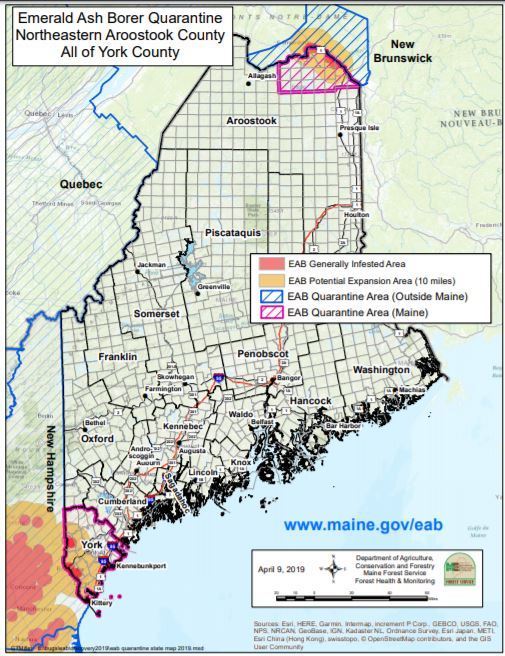 |
Ground-Nesting Bees - Although the weather is still a bit wintery at times, we will soon see solitary ground-dwelling bees emerge and become active. When they first emerge in early spring, they are usually very active, with much flying around, mating, exploration and nest-building. As people increase their yard-work activities, they begin to notice the bees. All this activity by bees can look frightening. However, solitary bees (one nest for each female, although you may have many nests in one area) are generally non-aggressive and will not sting unless severely harassed. The males can often act very aggressive while they fly around searching for a mate, but they can’t sting at all. This heightened activity persists for only a week or two, and then the bees are almost unnoticeable. Ground nesting bees are valuable pollinators.
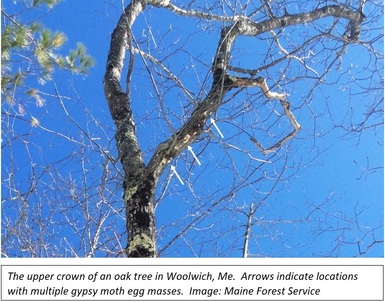
Gypsy Moth (Lymantria dispar) – Defoliation likely: Last year, several reports of light defoliation caused by gypsy moth were received by our offices. Winter egg mass surveys and staff observations support the likelihood of noticeable gypsy moth-caused defoliation in the Woolwich area (Sagadahoc County) this spring, as well as in areas around Springvale (York County). Forest Health Specialist Nicole Keleher with the Massachusetts Department of Conservation & Recreation provided protocols being tested in MA, which our staff employed in Woolwich, Wiscasset (Lincoln County) and Arrowsic (Sagadahoc). Those surveys predict moderate to severe defoliation by gypsy moth in parts of Woolwich (72 egg masses/acre) and Wiscasset (almost 400 and more than 400 egg masses/acre); the Arrowsic survey revealed no egg masses (defoliation by gypsy moth should not be significant). Additional plots are being surveyed this spring. We will monitor actual defoliation at sites across the coastal bioregions as we test this protocol in Maine. Of course, gypsy moth is not the only active defoliator in the Midcoast area. Winter moth and browntail moth are also present. Forests are also under stress from intermittent drought conditions.
Although surveys did not reveal other areas to watch, it would not be surprising if gypsy moth damage appears in other areas this year. We recommend postponing harvest entries in areas affected by significant defoliation or other significant stress. Harvest can add stress to already impacted trees, and can concentrate pest populations on those remaining. New Hampshire’s Division of Forests & Lands has a concise explanation in this information regarding an outbreak of the native forest tent caterpillar: https://www.nhdfl.org/Community/Forest-Health/Forest-Tent-Caterpillar.
There is still time to scrape and destroy egg masses within reach, especially on or near prized ornamental trees, but that time is getting short (try to complete this task by the first week of May). More information on gypsy moth biology in Maine can be found on our website: https://www.maine.gov/dacf/mfs/forest_health/insects/gypsy_moth.htm
|

Quarantine News: During the January through February public comment session for the gypsy moth quarantine rule, Gary Fish, the State Plant Regulatory Official with the Horticulture Program, received significant comments in support of a full-state quarantine on this pest. That revised approach is now open for public comment through April 26th. Read about the public comment period. Comments can be sent to gary.fish@maine.gov or mailed to Gary Fish, Maine DACF, 28 State House Station, Augusta, ME 04333-0028. The public comment period is your opportunity to impact the outcome of this proposed rule.
What would a full state quarantine mean? Essentially, the result would be dropping the internal state quarantine. A federal quarantine would be effective across the entire state. Impacts are likely to be more economic than biological.
Regulated articles include logs, wood chips and Christmas trees, among others. Within the regulated area, movement of regulated articles would not be impacted by the quarantine, allowing for less record keeping and fewer constraints on the part of shippers and receivers. An inspection and resulting phytosanitary certificate would be necessary for movement of regulated articles to areas outside the regulated area (see map).
Biologically, gypsy moth populations will continue to slowly move northward, as they have with the quarantine in place. Cold winter temperatures will slow their spread; eggs above snow line are vulnerable to freezing. Finding food is not an issue for gypsy moth; it has over 300 known hosts. In northern parts of the state, it thrives in aspen and birch forests.
|
Hemlock Woolly Adelgid (Adelges tsugae) – Hemlock woolly adelgid (HWA) eggs and/or crawlers (mobile stage of HWA) are now present and will be more-or-less continuously present until late July or early August. These life-stages can be spread on many items other than the host trees (clothing, equipment, vehicles, pets, etc.). If possible, postpone major tree work in infested hemlock stands until August to reduce spread of HWA. Remember that HWA is a quarantined pest. Live, rooted hemlocks and recently cut branch material pose the highest risks for spreading this pest. Roundwood products such as logs and pulp may be moved freely within Maine, but must be free of foliage. Material with branches, such as chips, moved outside the quarantine area must go to facilities with agreements to receive that material.
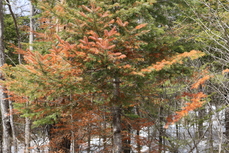
Winter burn and salt damage-In late winter, evergreens with uncharacteristic orange-colored foliage are commonly seen along roadsides, forest edges and among landscape plantings. these symptoms are oftern due to winter burn or salt damage.
Photo: Orange foliage typical of roadside trees (here, balsam fir and hemlock) in late winter suffering from winter burn and/or road salt.
Winter burn results when the aboveground portions of evergreens are exposed to warming air temperatures. This stimulates photosynthesis, involving the opening of pores in the foliage (stomata) for gas exchange. If the ground remains frozen and the lost water is not replaceable by the roots, there is not enough moisture to sustain the needles and fine branches, causing these tissues to die. Once desiccation occurs, the plant tissues are irreversibly damaged and will not recover. While all evergreens are more-or-less equally susceptible to winter burn, a tree’s location is the most significant factor determining the degree of damage. Trees receiving elevated levels of transmitted/reflected heat and light (often first seen on the south side of trees) are prone to winter burn. Winter burn damage is worsened if the trees have been exposed to ice-melting products during winter.
Salt damage occurs when trees are exposed to ice-melting products used on, for example, roads and sidewalks. These products are sometimes transported to nearby trees in the form of mist created by vehicles. Particularly, ice melt products containing sodium often cause salt damage symptoms that appear similar to winter burn. When foliage and new buds for next year’s growth are exposed to salts, moisture is drawn out of the tissues and desiccation occurs killing important plant tissues. This damage is commonly seen affecting conifers along high-traffic roadways. Trees growing in lower sites may be affected by salts later in the year as well, where roots are shallow and salts may accumulate via runoff. Salts inhibit plant root ability to absorb necessary nutrients, leading to poor vigor.
Little can be done to limit the impact of winter burn and salt damage, aside from preventative measures already taken in the fall and winter (wrapping trees, shading trees, careful use of less-impactful deicing materials, like those containing calcium). While this damage can adversely affect tree growth and vigor, most trees will recover quickly when new foliage begins to develop in spring and spring rains wash salt away. If the damage was severe enough to kill buds, recovery will be significantly slower. A check of bud vitality can give a rapid indication of damage severity. Living branch tips and buds should be bright green under the bud scales and bark.
|
Red Pine Survey Planned for field season 2019 – The Maine Forest Service will be conducting a statewide red pine health survey during the 2019 field season. The main objectives of the survey will be assessing the general health of Maine’s red pine resource and identifying the prevalent diseases affecting red pine. If you have a red pine stand over two acres in size and would consider letting Maine Forest Service Forest Health staff assess the stand, please contact Aaron Bergdahl, Forest Pathologist with the Maine Forest Service at 287-3008 or at aaron.bergdahl@maine.gov.
Monday, April 29, 12pm: Browntail Moth Informational Session Hosted by the Waterville Rotary Club
Free
Where: Best Western Hotel 375 Main Street Waterville, ME
Saturday, May 4, 2-4pm: Invasive Species Forum with Maine Forest Service, Acadia National Park, Somes-Meynell Wildlife Sanctuary, Land & Garden Preserve, Mount Desert Sustainability Committee. Free
Where: Neighborhood House, Northeast Harbor. Call Billy Helprin (207) 460-9390 for more information.
Wednesday, May 15, 10am-12pm: Tree and Invasive Forest Pest Identification and Survey with Melissa Brandt (York County Soil and Water Conservation District), Colleen Teerling and Oliver Markewicz (Maine Forest Service)
Learn basic tree identification, how to ID invasive forest insect pests threatening York County, and how to survey for them in your own trees. This is an outdoor event, so dress for the weather. For more information, contact Melissa Brandt (information below).
Free - please pre-register by calling Melissa Brandt at (207) 324-0888 (ex 214) or emailing melissabrandt@yorkswcd.org
Where: Holdsworth Park, Springvale. Parking off Route 109. If the weather is bad, this will be held at 21 Bradeen St, Springvale (there will be a sign at the park if this happens).
For more information contact (207) 287-2431
Office hours are 7:30 am to 4:00 pm, Monday through Friday, except for holidays. If you plan to visit either office, you may wish to call ahead just to make sure someone will be present to meet with you. (207) 287-2431 (Augusta) and (207) 827-1813 (Old Town)
NOTE: The Augusta office has moved to the Deering Building, 90 Blossom Lane. 50 Hospital Street is no longer open to the public. The mailing address and phone numbers are unchanged. A map is available on our website, https://www.maine.gov/dacf/mfs/forest_health/contact_us.html.
Conditions Report No. 1, 2019
On-line: http://maine.gov/dacf/mfs/publications/condition_reports.html
Department of Agriculture Conservation & Forestry
Maine Forest Service - Forest Health and Monitoring
Contributors: Aaron Bergdahl, Allison Kanoti, Thomas Schmeelk, and Colleen Teerling
|